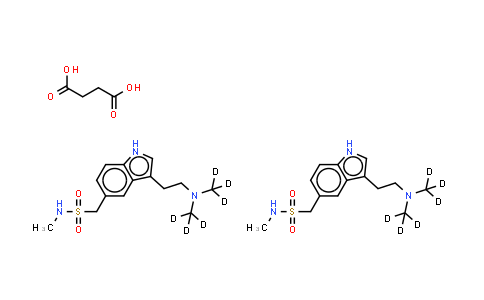
Sumatriptan (succinate) NLT 98%
Product Number : MC503484
CAS Number : 103628-48-4
Molecular Formula : C32H48N6O8S2 | Molecular Weight : 720.96
Synonyms : GR 43175
Quote Request| Purity | NLT 98% |
|---|---|
| Storage | at 20ºC 2 years |
| MolCore specializes in manufacturing high-purity CAS No.103628-48-4, Sumatriptan (succinate) with the molecular formula C32H48N6O8S2 and molecular weight 720.96 delivering critical API intermediates for global pharmaceutical and research industries, certified under ISO quality systems. | |
* The above information is for reference only.
| Chemical Name | Sumatriptan (succinate) |
|---|---|
| CAS Number | 103628-48-4 |
| MDL Number | MFCD08063531 |
| Molecular Formula | C32H48N6O8S2 |
| Molecular Weight | 720.96 |
| Synonyms | GR 43175 |
Sumatriptan succinate (GR 43175) is a serotonin1 (5-HT1) receptor agonist, which is effective in the acute treatment of migraine headache. Target: 5-HT 1d receptor agonist Sumatriptan succinate is a serotonin1 (5-HT1) receptor agonist, which is effective in the acute treatment of migraine headache. Its antimigraine activity is believed to derive from selective vasoconstriction of cranial blood vessels which are dilated and distended during migraine headache and/or from inhibition of neurogenically mediated inflammation in the dura mater [1]. For sumatriptan succinate 50 mg versus placebo the NNTs were 6.1, 7.5, and 4.0 for pain-free at two hours and headache relief at one and two hours, respectively. NNTs for sustained pain-free and sustained headache relief during the 24 hours postdose were 9.5 and 6.0, respectively [2]. Difference in time-weighted (0-2.5 h) mean arterial pressure MAP (90% confidence interval) was 1.2 mmHg (-0.2, 2.7) between telcagepant and placebo, 4.0 mmHg (2.5, 5.5) between sumatriptan succinate and placebo, and 1.5 mmHg (0.0, 3.0) between telcagepant with sumatriptan succinate vs sumatriptan succinate alone. When coadministered with telcagepant, the AUC0-6h and C(max) of sumatriptan succinate were increased by 23% and 24%, respectively. The small MAP increases observed after coadministration could possibly be associated with the slight elevations in sumatriptan succinate levels [3]. Clinical indications: Cluster headache; Migraine Toxicity: Symptoms of overdose include convulsions, tremor, paralysis, inactivity, ptosis, erythema of the extremities, abnormal respiration, cyanosis, ataxia, mydriasis, salivation, and lacrimation
© Copyright 2015-2025 Hangzhou MolCore BioPharmatech Co.,Ltd. All rights reserved.
